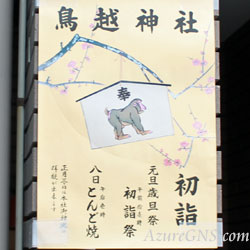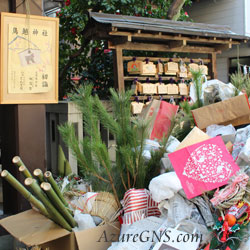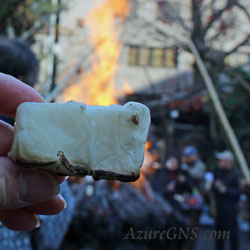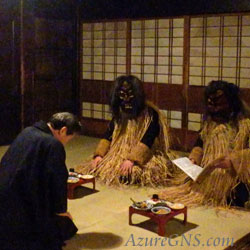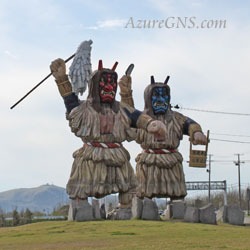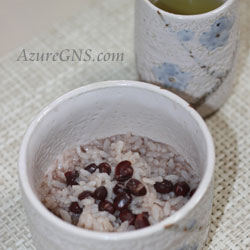(1月15日頃)
Ko-shogatsu;
Little New Year
(around January 15th)
●小正月 Ko-shogatsu; Little New Year
●女正月 Onna-shogatsu; Woman’s New Year
●元服 Gempuku; Coming of Age Ritual for a Boy
●成人の日 Seijin-no-hi; Coming-of-age Day
●正月飾り New Year decoration
●門松 Kado-matsu; a pair of traditional Japanese decoration made of pine branches and bamboo
●火祭り fire festival
●焚火 bonfire; open-air fire
●炎 flame; blaze
●神社 a shrine
●寺 a temple
●境内 precincts
●餅 mochi; rice cake
●小豆粥 azuki-gayu; rice gruel with red beans
●民族信仰 folk belief
●伝統 traditional
◆小正月と正月15日、または1月14日から16日までの3日間のことを称します。
Ko-shogatsu is the 15th day of New Year or three days from the 14th to the 16th of January.
◆元旦から15日までを松の内と呼び、小正月まで、またはその前夜まで正月飾りや門松を飾ります。
The days from New Year’s Day to the 15th are called Matsu-no-uchi, and New Year’s decorations and Kado-matsu are placed until Ko-shogatsu or the evening of the previous day.
◆しかし今日では一般的に1月7日または8日に正月飾りや門松を片付けます。
However, these days, New Year’s decorations and Kado-matsu are usually taken away on January 7th or 8th.
◆地方によっては小正月は女正月とも呼ばれ、年末からお正月にかけて正月準備や来客の接待などで忙しく過ごした妻をねぎらいます。
In some districts, Ko-shogatsu is also called Onna-shogatsu (Women’s New Year) when wives are thanked because they are very busy for New Year’s preparations and receptions of guests from the end of the year to the New Year.
◆その日は夫が妻の代わりに家事をしたり、妻が里帰りをしたりするなどゆっくり過ごします。
On the day, some husbands do housework for their wives and some wives visit their parents’ home.
◆かつては小正月に元服を行ったので、その名残から1948年(昭和23年)に国民の祝日の成人の日が1月15日に制定されました。
Long ago, people celebrated their Gempuku on Ko-shogatsu, and therefore, Seijin-no-hi (Coming-of-Age Day), one of the National Holidays, was instituted in 1948 (Showa 23rd yr) as to be celebrated on January 15th.
◆しかし2000年(平成12年)に「ハッピーマンデー制度」が導入され、成人の日は1月第2月曜日に変更されました。
However, it was changed to the second Monday of January, in 2000 (Heisei 12th yr), according to a new law called “The Happy Monday System”.
◆小正月には全国で左義長と呼ばれる主に子供が楽しむ火祭りが行われます。
Fire festivals called Sagicho mainly for children take place all over Japan on Ko-shogatsu.
◆この火祭りは地域によっては「どんど焼き」、「とんど焼き」、「さいと焼き」、「三九郎焼き」などと呼ばれ、祭次第や決まりも様々です。
These fire festivals have many different names in many regions such as “Donto-yaki”, “Tondo-yaki”, “Saito-yaki” and “Sankuro-yaki”, and their programs and rules vary from region to region.
◆悪霊の侵入防止や、交通安全の神として民間信仰されている道祖神の祭りと結びついていることも多いです。
Many of them are connected with the festivals of Dososhin (guardian deity) which are believed to be deities of evil spirit prevention and traffic safety according to folk beliefs.
◆刈取りが終わった田んぼや神社の境内で大きな焚火をして、正月飾りや門松を燃やします。
Big bonfires are made in already harvested rice paddies or precincts of shrines, and New Year’s decorations and Kado-matsu are burnt in them.
◆燃え上がる炎と共に祈りと感謝を込めて年神様を送り出します。
Toshi-gami (a New Year Shinto deity) is sent back with rising flames while people pray and appreciate it.
◆通例1月2日に書かれる書き初めも燃やし、その炎が高く舞い上がれば上がるほど字が上達するそうです。
Kaki-zome (the first calligraphy practice of the year), which is usually written on January 2nd, is also put into the fire, and it is said that people will make more progress in calligraphy as the flames of the fire rise higher.
◆子供達は左義長で小枝に刺したお餅や団子を焼いて食べることを楽しみにしています。
Children look forward to toasting mochi (rice cake) or dumplings on twigs over Sagicho and eating them.
◆左義長の灰を家の周りに撒いたり、体に塗ったりすると、無病息災に1年を過ごすことができると言われています。
It is also said that people will live in good health during the year if they put ash of Sagicho on their bodies or around their houses.
◆秋田県男鹿半島のナマハゲは、現在は大晦日に行われますが、かつては小正月に行われていました。
Nowadays Namahage is performed in the Oga Peninsula, Akita Prefecture on New Year’s Eve, but it used to be performed on Ko-shogatsu.
◆怠け心を戒め、無病息災、五穀豊穣、豊かな山の幸や海の幸を祈るとても有名な民俗行事で、その起源は江戸時代(1603年-1867年)に遡ります。
This is a very famous folk event to admonish laziness and pray for good health, abundant harvests and rich produce from mountains and oceans, and its origin dates back to the Edo Period (1603-1867).
◆1978年(昭和53年)に重要無形民俗文化財に指定されました。
It was designated as a National Important Intangible Folk Cultural Property in 1978 (Showa 53rd yr).
◆それぞれの集落の若者が鬼の面をかぶり、蓑をまとい、手に鉈や出刃包丁を持って家々を訪れます。
Young men, who wear a devil’s mask and a straw rain cape and have a sickle or a big kitchen knife in their hands, visit houses in their districts.
◆訪れた家々で、「悪い子はいねがー」、「泣ぐ子はいねがー」と大声をあげなら暴れます。
They shout out, “Warui-ko wa inega!?” and “Nagu-go wa inega!?” (“Are there any misbehaving children?” and “Are there any crying children?” in a dialect of the district) and act wildly at the homes they visit.
◆正装した家の主人がナマハゲを迎え、なだめて酒や料理をふるまって帰ってもらいます。
The masters of the homes in formal wear serve sake (Japanese rice wine) and food to them and ask them to leave their homes.
◆小正月を祝う伝統的な食べ物は小豆粥です。
The traditionally celebrated dish for Ko-shogatsu is azuki-gayu (rice gruel with red beans).
◆大概、小正月の朝に食べ、焼いたお餅を入れることもあります。
Usually people eat it on the morning of Ko-shogatsu and sometimes put roasted mochi in it.
Copyright (C) Azure Global Network Services. All Rights Reserved.


